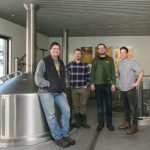
By Anna Boisseau
Because of something called the “purity law,” water, hops, yeast and barley are the only four ingredients allowed in German beer. And so, unlike the more experimental nature of the American craft brew scene, German brewers tend to be purists. There’s a right way to make Pilsner, Oktoberfest and Kölsch beers. That’s why Marius Hartmann was so surprised when he first tasted Kellerweis, Sierra Nevada’s take on a traditional German Hefeweizen beer. As a Brewing and Beverage Technology student at the University of Applied Science Weihenstephan-Triesdorf, Marius and his peers often sampled international pints. “He didn’t know an American brewery could actually make a good Hefeweizen,” ponders Abe Kabakoff, the head pilot brewer at Sierra Nevada.
After realizing international work experience would set him apart from others in his program, Marius decided to work on his English. In 2014, he enrolled in a course at California State University Chico, which is in the same city as the Sierra Nevada brewery. That’s when he met with Abe to discuss the possibility of an internship, which eventually worked out.
This is Sierra Nevada’s first time hosting an international intern through the J-1 Visa program. However, Abe is no stranger to the benefits of working abroad. It’s actually what brought him to a career in brewing beer in the first place. While in college, he opted to spend a year in Germany as part of the Congress-Bundestag Youth Exchange for Young Professionals. Even though Abe was studying computer science at the time, he decided to mix things up by interning at a brewpub outside Munich. The brewmaster left during Abe’s internship, so for two weeks it was his sole responsibility to run the brewery.
“I don’t think I’d be in the brewing business if I hadn’t done that program,” Abe says.

While Marius’ internship at Sierra Nevada isn’t setting him on a new life path, it is opening his horizons to a different beer culture. At Sierra Nevada, they brew three to four different kinds of beer a week—a stark contrast from his home country, where they have five beer styles in total.
Since starting at Sierra Nevada, Marius has embraced the more experimental style of U.S. craft beer. During his stint at the pilot brewing part of Sierra Nevada, Marius created his own winter beer using spices like coriander, ginger and nutmeg. He named it “Lebkuchen,” after the German equivalent of gingerbread.
“It was probably one of greatest experiences, because in past weeks and months I learned about the pilot brewery…and after three months I could make my own recipe,” Marius recalls. The brew made it out to Sierra Nevada’s tasting room, where it was well received. “I never had the experience to brew with those ingredients,” he says. “I’m happy it turned out how I wanted.”
This exchange program has been helpful for Sierra Nevada as well. The company learned that most people preferred the taste of the traditional German lager, which is aged four to five weeks, instead of their method of aging it only 18 days.
Additionally, Sierra Nevada has something in common with the traditionalist style of German brewing. They also like to stick to the same four ingredients required in German law. This way, they can avoid adding in unnatural ingredients. So for Abe, it was valuable to get Marius’ insight into how Germans approach Reinheitsgebot.
This article was first published on www.culturalvistas.org. Reprinted with kind permission by Cultural Vista.
About the Author: Anna Boisseau
Anna Boisseau dreamed of being an ambassador as a child, and working as a Communications Officer at Cultural Vistas has gotten her pretty close. She enjoys cheering for the Kansas City Royals, cooking farm-fresh cuisine and binge watching Amazon’s “Good Girls Revolt.” For more information visit www.culturalvistas.org